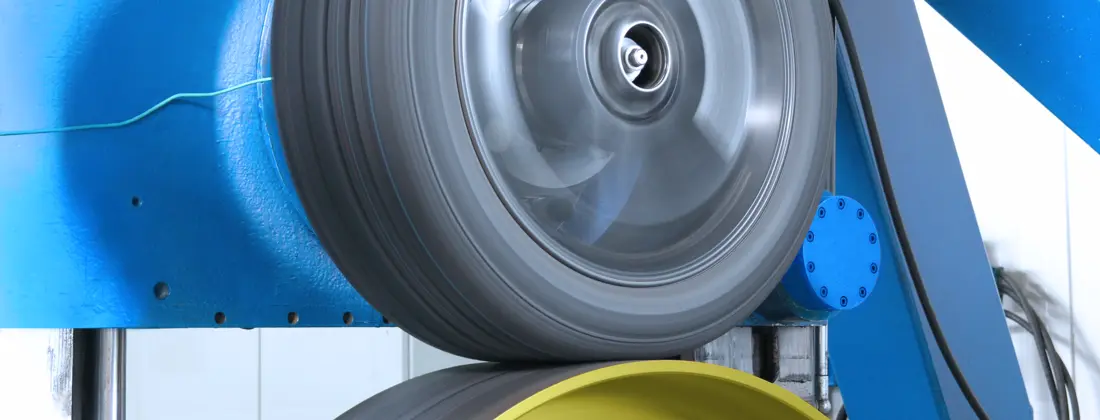AIS 151 Retreaded Tyre Durability Testing
The AIS 151 standard is a critical benchmark in the retreading industry, ensuring that reused tyres meet stringent durability and performance standards. This test evaluates the wear resistance, tear resistance, and overall structural integrity of retreaded tyres through rigorous mechanical testing. The primary objective is to assess how well these tyres perform under real-world conditions, thereby safeguarding road safety and enhancing tyre longevity.
Retreading tyres has significant environmental benefits, reducing waste and extending the life cycle of rubber products. However, it also demands stringent quality control measures. Compliance with AIS 151 ensures that retreaded tyres are not only safe for use but also meet the highest performance standards required by law and industry.
For tyre manufacturers and distributors, compliance with AIS 151 is essential to maintain a strong reputation in the market. It is particularly crucial for quality managers, procurement officers, and R&D engineers who need to ensure that their products are not only durable but also environmentally responsible. The test involves several key parameters:
- Rolling resistance
- Traction performance
- Sidewall integrity
- Curb cut resistance
- Water management capability
The testing process begins with the selection of appropriate test specimens, which are carefully prepared to replicate real-world tyre usage conditions. Once selected and mounted on a suitable wheel, these tyres undergo multiple cycles of loading and unloading using specialized equipment that simulates actual driving conditions.
During each cycle, precise measurements are taken to monitor the tyre’s performance under load. These include monitoring temperature changes within the tyre structure to ensure it remains within safe operating limits. Additionally, detailed inspections are conducted post-testing to evaluate any signs of wear or damage.
The results from these tests provide valuable insights into the durability and safety aspects of retreaded tyres. Compliance with AIS 151 ensures that these tyres meet not only regulatory requirements but also exceed expectations in terms of performance and reliability. This is particularly important given the growing demand for sustainable tyre solutions globally.
For quality assurance purposes, laboratories adhering to AIS 151 standards use state-of-the-art equipment and methodologies to ensure accurate results. This includes advanced instrumentation capable of measuring minute changes in tyre dimensions and structural integrity over extended periods. Such precision is vital for ensuring that every retreaded tyre meets the stringent requirements set forth by this standard.
Compliance with AIS 151 also plays a crucial role in enhancing customer confidence, as it demonstrates a commitment to maintaining high standards of product quality. This is especially relevant for those involved in procurement processes where reliability and safety are paramount considerations.
Why It Matters
The importance of AIS 151 compliance cannot be overstated, particularly for entities operating within the automotive industry. By adhering to this standard, manufacturers can ensure that their retreaded tyres meet or exceed global safety and performance standards. This not only enhances brand reputation but also contributes positively towards environmental sustainability goals.
Compliance with AIS 151 is essential because it helps maintain consistent quality across different batches of retreaded tyres produced by various manufacturers. This consistency ensures that consumers receive reliable products every time, regardless of the supplier or production facility involved. It promotes trust among buyers who rely on trusted brands for their purchasing decisions.
Furthermore, AIS 151 compliance supports regulatory requirements imposed by governments worldwide aimed at improving road safety and reducing emissions associated with tyre manufacturing processes. By adopting this standard, companies can contribute towards achieving these objectives while also benefiting from enhanced customer satisfaction levels resulting from superior product performance.
In summary, adherence to AIS 151 is vital for maintaining a competitive edge in today’s market where consumer expectations regarding quality and sustainability are increasing rapidly. For businesses involved in tyre retreading operations, ensuring compliance with this standard can lead to significant long-term benefits including improved brand loyalty and reduced operational risks.
International Acceptance and Recognition
- AIS 151 Compliance: Widely recognized across Europe, North America, and Asia-Pacific regions for its stringent criteria in assessing retreaded tyre durability. Many countries mandate compliance with this standard as part of their national regulations.
- Regulatory Influence: The standard influences numerous international standards related to tyre safety and performance. Its principles are frequently referenced or adopted by other bodies responsible for establishing global guidelines.
The widespread acceptance of AIS 151 underscores its significance in the field of tyre testing. Laboratories around the world have embraced this standard due to its comprehensive approach to evaluating retreaded tyres' durability, ensuring that they meet both local and international requirements.
Compliance with AIS 151 is not just a requirement but also an opportunity for companies to demonstrate their commitment to maintaining high standards of product quality. This recognition enhances the credibility of manufacturers and distributors in the eyes of consumers seeking reliable tyre solutions.
Environmental and Sustainability Contributions
- Resource Efficiency: Retreading tyres significantly reduces waste by extending their lifecycle, thereby conserving natural resources such as oil used in rubber production. This practice contributes positively to reducing the carbon footprint associated with tyre manufacturing.
- Emissions Reduction: By promoting reutilization of existing tyres instead of producing new ones from raw materials, retreading helps lower greenhouse gas emissions throughout the tyre lifecycle.
The implementation of AIS 151 further supports these environmental benefits by ensuring that retreaded tyres not only meet durability standards but also perform optimally under various driving conditions. This dual focus ensures that both safety and sustainability are prioritized in every aspect of tyre production and usage.
For businesses committed to reducing their ecological impact, compliance with AIS 151 represents an effective strategy for aligning corporate social responsibility initiatives with operational practices. By embracing this standard, companies can contribute meaningfully towards global efforts aimed at combating climate change and promoting sustainable development goals.





